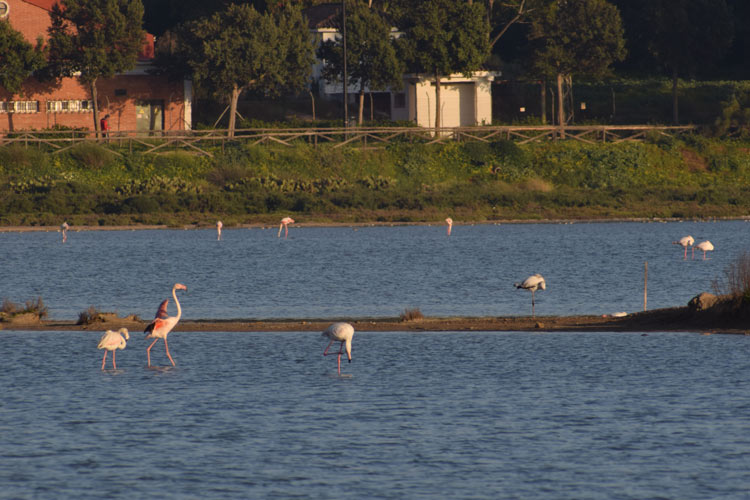Transform water management to strengthen the Bahía de Cádiz Natural Park in the face of climate change
Hidralia highlights the importance of caring for and restoring the wetlands of San Fernando to overcome the climate crisis on the occasion of World Wetlands Day
Ramsar, the Convention on Wetlands that offers the framework for the conservation and rational use of these natural spaces and their resources, celebrates World Wetlands Day every February 2, focusing its action in 2024 on the theme of ' Wetlands and human well-being'. In this way it seeks to highlight the great interconnection between wetlands and human life, as people draw sustenance, inspiration and resilience from these productive ecosystems.

Precisely, the Bahía de Cádiz Natural Park is a Ramsar Site, highlighting its international importance due to the number of species (flora and fauna) it houses, and San Fernando is where you can clearly see the interaction between people and this medium, since it surrounds the entire municipality.
A challenge of integration between the urban and the natural that Hidralia, responsible for the city's sanitation and supply service, is aware of, which has taken advantage of this International Day to highlight the importance of the transformation of water management, which is taking place in the town, and how among its objectives it seeks to strengthen the Bahía de Cádiz Natural Park.
One of the points that Hidralia has been working on for some time is the renewal of the networks. The objective is for the pipes to have a longer life, with less risk of breakdowns and to reduce possible water losses.
Something that is important for the environment in the case of the sanitation system. In fact, Hidralia is taking action to adapt the city's evacuation systems to the new reality presented by climate change, with increasingly intense rainfall in shorter periods of time, which can collapse the sewage network. .
That is why Hidralia continues to advance in the introduction of sensors throughout the network, in the global treatment of the data obtained, in the development of sewer cleaning programs and comprehensive management of the pipes and filling stations. pumping. The objective is not only to have a network prepared, but to be more efficient when acting and using the necessary resources in those areas whose information indicates that there may be complications, both before, during and after the rainy episode.
On the other hand, more and more projects and initiatives are being developed to make use of regenerated water, that which has been previously treated in water purification stations so that it can be used again in activities such as agriculture. or the irrigation of green areas.
But for it to be viable, it is necessary to have a network that allows this water to reach the different spaces of the city. In this way, Hidralia has been preparing San Fernando for some time so that it has the appropriate infrastructure so that it can use this resource at the same time that it can be counted on. Currently, the city already has 13.5 kilometers of networks for reused water with diameters between 100 and 400 mm.
Social pact
But, as Ramsar states for this day, “the restoration of wetlands is essential to overcome the climate and biodiversity crisis, as well as to achieve the Sustainable Development Goals for the benefit of all people.” Something that Hidralia also believes in, which is why it integrated into its Social Pact for Solidarity, Employment and the Green and Inclusive Reconstruction of San Fernando actions to improve the Bahía de Cádiz Natural Park.
The entity that manages this natural space actively participated in the Green and Inclusive Reconstruction tables, to achieve an ecological transition towards a sustainable, inclusive and fair socioeconomic model, based on the circular economy, in order to combat climate change and its effects, protecting ecosystems and biodiversity.
In this way, among its measures, it was agreed to commit to the circular economy and promote the use of green energy and the enhancement of the natural environment of San Fernando, with the search for resources to recover spaces in the Visitor Center area.
“In San Fernando you can see how we depend on the state of the wetlands to achieve social well-being. They support biodiversity, improve air quality, reduce the temperature of urban areas, build a barrier against flooding and provide resources for new economic activities. We have examples of all of the above in San Fernando, from how it served as protection for catastrophes such as the earthquake of 1755, which produced a tsunami that reached the Cádiz coast, or how the salt flats and estuaries have been an economic support for many island families. Now there are new development opportunities linked to the natural park, especially tourism, but this requires an environment that is healthy and it is something that worries us and for this reason, we have put Green Reconstruction and the fight against Climate Change as one of the work axes of the Hidralia Social Pact in San Fernando, because we are convinced of the capacity of the Bahía de Cádiz Natural Park to mitigate the effects of climate change," said the manager of Hidralia, José Luis Trapero.
